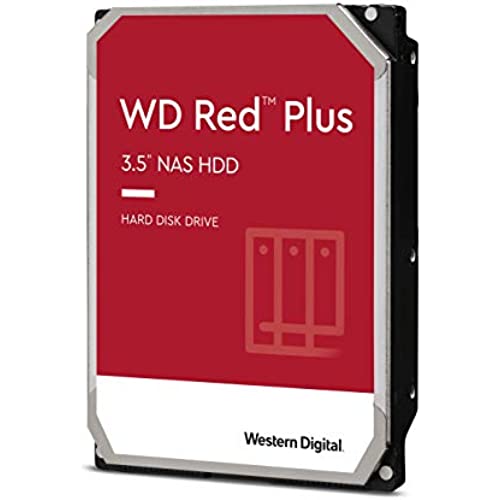
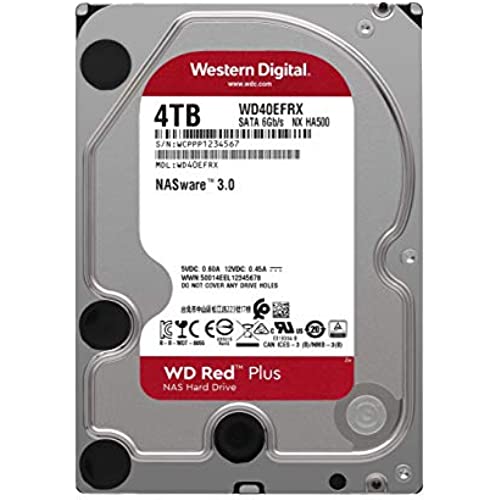
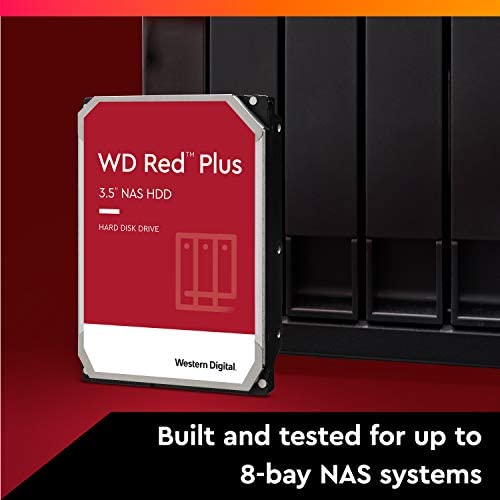
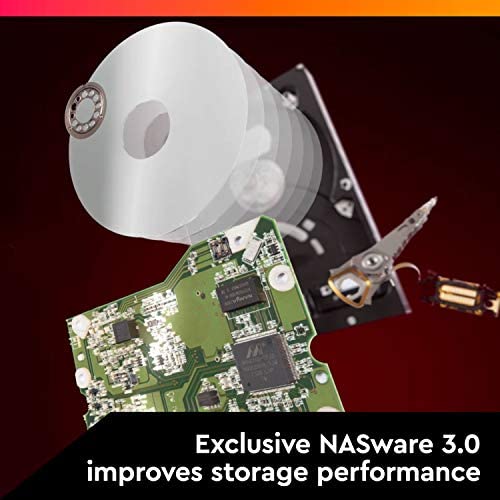

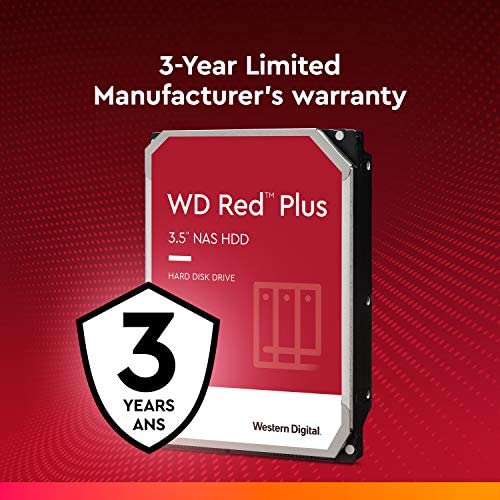
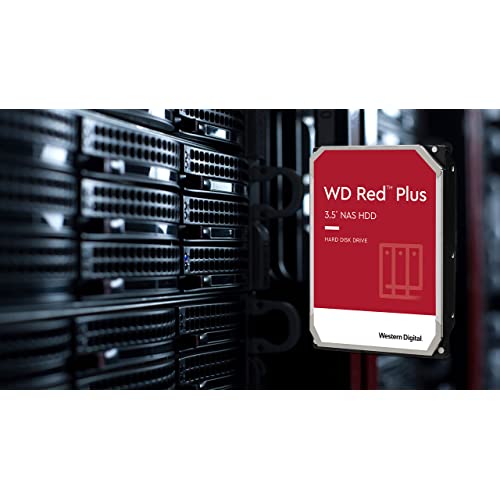







Western Digital 4TB WD Red Plus NAS Internal Hard Drive HDD - 5400 RPM, SATA 6 Gb/s, CMR, 64 MB Cache, 3.5 - WD40EFRX
-

Pravesh Soni
> 3 dayWhy 4 Stars instead of 5? The fact is that every mechanical hard drive will eventually fail depends on the usage and its manufacturing process control. However I can say these are the second most reliable drives. The at first place is HGST no doubt. If you are budget conscious, these are the best. I recommend to have same series drives in your NAS to get best performance and reliability. I was in habit to have a different capacity of the drives with multiple manufacturerers and ended up with frustration and no data loss thanks to the data protection and parity of the volume. I started to build my NAS with a set of 2x2TB drives and over time I increased my storage to 10TB with the same drives. Ill stick with 2TB drives to expand my storage until WD will stop manufacture not due to the fact that these are the cheapest, it is due to the fact of the existing set of drives. Im not even expecting any drive will last long as 5 years. The first set of drives which I bought is now surpassed more than three and half year and no bad sectors yet. Although Ill be expecting the first failure of the drive within a year. At the end, I say I didnt made a bad decision.
-

makoman50
> 3 dayI recently purchased four of these drives to make a new storage array in my workstation. I connected them in two pairs of Raid Mirror on a PCI controller board (with a backup controller) and then using windows to negotiate nightly backups between the two of them. Ive owned numerous western digital hard drives over the years and theyve hands-down been the most reliable. I was unsure about the Red Series of drives, however so far theyve been behaving well. Pros; Extremely high capacity-to-price ratio. Only exceeded by the Green series drives (which I would avoid due to performance issues) Sata 3 interface (not that this will saturate a sata channel, but its still nice) Large Cache 3 year Warranty Cons; I had been looking at using 2.5 drives due to heat, electricity and weight savings. WD doesnt make 2.5 drives anywhere near this large and they are prohibitively expensive per GB Theyre heavy. While normally not a huge consideration, for me it was, bear with me. It would be nice to have a 5 year warranty It would nice if they were fixed 7200 rpm drives, or at least if this was settable for those of us that want to keep out drives spinning all the time. Overall though; Unless you want to buy RE4 Enterprise level drives I would get these again. I will update this with any issues I have. NO MATTER WHAT THIS DOES NOT SUBSTITUTE A WELL THOUGHT OUT BACKUP SOLUTION. EVER. Seriously, go back your stuff up, RIGHT NOW.
-

somerandomguy
> 3 dayI have purchased 6 of these 4 TB WD Red drives for a Synology DS2413+ NAS. Installed the drives, partition and deep scan took about 12 hours for a single drive setup and about 20 hours for the same with a RAID 1. I dont require anything else yet as I have offline backups and not yet enough storage to mirror all of the drives online, I dont want any smaller drives on the NAS. I plan on setting up multiple RAID 1s as I add drives to this system. They are easy to build and rebuild if I have problems. All six drives are in a basement area at 68f and the drive temps are 72f-73f. The were 83f when scanning and formatting. The packaging was superb, each drive is in its own brown cardboard box with plastic ends to keep the drive from shifting and then was packed in a larger box. No errors or problems with these drives so far. I need six more before I can get all of my movies and music online, will take awhile to image all of my retail DVDs and CDs. The NAS and the memory for it were also packed well and are running well. Love Amazon for their free shipping as a prime member, this almost paid for the years worth. Update 12-Dec-13 So far the drives are running fairly cool and are very quiet, I have added 2 more of the 4TB models to my Synology DS2413 NAS. This did increase the temps slightly, they now hover around 83f when idle. Room temp is about 70f. The NAS has passive cooling on the board (though it does have an exhaust fan) so more drives adds more internal heat. They are pretty fast when transfering data (too lazy to run a speed test) over the network but it is more than fast enough to run multiple movie streams.
-

Lee DaSilva
> 3 dayalmost 3 years later(((2y, 5m, 15d, 11h))) its still doing ok using in a unraid box smart status 1 Raw read error rate 0x002f 200 200 051 Pre-fail Always Never 0 3 Spin up time 0x0027 180 174 021 Pre-fail Always Never 4000 4 Start stop count 0x0032 097 097 000 Old age Always Never 3105 5 Reallocated sector count 0x0033 200 200 140 Pre-fail Always Never 0 7 Seek error rate 0x002e 200 200 000 Old age Always Never 0 9 Power on hours 0x0032 071 071 000 Old age Always Never 21587 (2y, 5m, 15d, 11h) 10 Spin retry count 0x0032 100 100 000 Old age Always Never 0 11 Calibration retry count 0x0032 100 253 000 Old age Always Never 0 12 Power cycle count 0x0032 100 100 000 Old age Always Never 26 192 Power-off retract count 0x0032 200 200 000 Old age Always Never 22 193 Load cycle count 0x0032 199 199 000 Old age Always Never 3082 194 Temperature celsius 0x0022 118 109 000 Old age Always Never 29 196 Reallocated event count 0x0032 200 200 000 Old age Always Never 0 197 Current pending sector 0x0032 200 200 000 Old age Always Never 0 198 Offline uncorrectable 0x0030 100 253 000 Old age Offline Never 0 199 UDMA CRC error count 0x0032 200 200 000 Old age Always Never 0 200 Multi zone error rate 0x0008 100 253 000 Old age Offline Never 0
-

Gary E. Peterson
> 3 dayHere is a quote from a review at pcper.com Im going to let the cat out of the bag right here and now. Everyones home RAID is likely an accident waiting to happen. If youre using regular consumer drives in a large array, there are some very simple (and likely) scenarios that can cause it to completely fail. Im guilty of operating under this same false hope - I have an 8-drive array of 3TB WD Caviar Greens in a RAID-5. For those uninitiated, RAID-5 is where one drive worth of capacity is volunteered for use as parity data, which is distributed amongst all drives in the array. This trick allows for no data loss in the case where a single drive fails. The RAID controller can simply figure out the missing data by running the extra parity through the same formula that created it. This is called redundancy, but I propose that its not. Since Im also guilty here with my huge array of Caviar Greens, let me also say that every few weeks I have a batch job that reads *all* data from that array. Why on earth would I need to occasionally and repeatedly read 21TB of data from something that should already be super reliable? Heres the failure scenario for what might happen to me if I didnt: * Array starts off operating as normal, but drive 3 has a bad sector that cropped up a few months back. This has gone unnoticed because the bad sector was part of a rarely accessed file. * During operation, drive 1 encounters a new bad sector. * Since drive 1 is a consumer drive it goes into a retry loop, repeatedly attempting to read and correct the bad sector. * The RAID controller exceeds its timeout threshold waiting on drive 1 and marks it offline. * Array is now in degraded status with drive 1 marked as failed. * User replaces drive 1. RAID controller initiates rebuild using parity data from the other drives. * During rebuild, RAID controller encounters the bad sector on drive 3. * Since drive 3 is a consumer drive it goes into a retry loop, repeatedly attempting to read and correct the bad sector. * The RAID controller exceeds its timeout threshold waiting on drive 3 and marks it offline. * Rebuild fails. At this point the way forward varies from controller to controller, but the long and short of it is that the data is at extreme risk of loss. There are ways to get it all back (most likely without that one bad sector on drive 3), but none of them are particularly easy. Now you may be asking yourself how enterprises run huge RAIDs and dont see this sort of problem? The answer is Time Limited Error Recovery - where the hard drive assumes it is part of an array, assumes there is redundancy, and is not afraid to quickly tell the host controller that it just cant complete the current I/O request. Heres how that scenario would have played out if the drives implemented some form of TLER: * Array starts off operating as normal, but drive 3 has developed a bad sector several weeks ago. This went unnoticed because the bad sector was part of a rarely accessed file. * During operation, drive 1 encounters a new bad sector. * Drive 1 makes a few read attempts and then reports a CRC error to the RAID controller. * The RAID controller maps out the bad sector, locating it elsewhere on the drive. The missing sector is rebuilt using parity data from the other drives in the array. *Array continues normal operation, with the error added to its event log. The above scenario is what would play out with an Areca RAID controller (Ive verified this personally). Other controllers may behave differently. A controller unable to do a bad sector remap might have just marked drive 1 as bad, but the key is that the rebuild would be much less likely to fail as drive 3 would not drop completely offline once the controller ran into the additional bad sector. The moral of this story is that typical consumer grade drives have data error timeouts that are far longer than the drive offline timeout of typical RAID controllers, and without some form of TLER, two bad sectors (totaling 1024 bytes) is all thats required to put multiple terabytes of data in grave danger. The Solution: The solution should be simple - just get some drives with TLER. The problem is that until now those were prohibitively expensive. Enterprise drives have all sorts of added features like accelerometers and pressure sensors to compensate for sliding in and out of a server rack while operating, as well as dealing with rapid pressure changes that take place when the server room door opens and the forced air circulation takes a quick detour. Those features just arent needed in that home NAS sitting on your bookshelf. What *is* needed is a WD Caviar Green that has TLER, and Western Digital delivers that in their new Red drives. End quote and back to reviewer. Ive got 5 of these in a
-

gadgetfreak
> 3 dayThis purchase was made as a replacement for the same drive that had recently failed after about 2 years of backup-only use. I do not test the drive for speed, as thats not its purpose (I have WD Blacks and SSDs for that). Im purchasing strictly for reliability. So why the 3 stars? Pros: - The drive offers good capacity at reasonable prices - Designed for use in NAS or other similar applications - Runs seemingly cool Cons: - I had one fail not too long into its life (e.g., ~2 years) - That warranty is potentially useless if, like me, you are nervous about sending a non-wiped drive back to WD for replacement. I will elaborate on the concern... I contacted WD about the failed drive, and they readily were willing to replace it. That being said, since the drive has failed (clicking sounds, etc.), it is impossible for me to get it to mount, and therefore it is impossible for me to erase the drive. I suspect that with very little effort, someone with a little hardware expertise -- e.g., lots of people at WD -- could get the drive working again and have ready access to all my info. Give this 4TB drive is the clone of my entire digital life, I just wasnt comfortable sending the drive back to the company. And of course, if I were to crack the thing open, Id void the warranty. Ive read lots of views online about WDs policies and procedures on protecting info, but when it came down to risking all my info, I wasnt able to pull the trigger on the exchange. For other utilitarian data, Id have no such qualms. Obviously, this is a personal choice and you may be more trusting than me. In which case, paying a little extra for a 5 year warranty makes sense. So consider what you would do in a similar situation as mine. If you have come to view spinning-platter drives as disposable items, consider saving a bit of money and buying something with a shorter warranty -- particularly in an application like mine (a clone) where its easy to swap a new drive in. Undoubtedly you will pay less per TB in a year or two. Or youll go SSD if the pricing is finally right.
-

Dr. Kattie O'Hara DVM
> 3 dayI purchased this from Amazon Warehouse in Used-Acceptable condition. Running an initial S.M.A.R.T. test revealed 0 Bad Sectors, however, the drive did have a drive reconnection count of 13. While 13 for this metric is not good, I monitor it weekly, and no new drive reconnects have occurred. As the drive had a relatively low 400 hrs when I received it, I was ok keeping the drive, given the 30% discount from full price. I recommend buying WD Red drives from Amazon Warehouse when the discounts are warrant it. I think these are a great value. Make sure to research the spin RPMs and whether the drive is CMR or SMR. Many of the WD Red drives may be advertised as 5400 RPM Class, but they actually run at 7200 RPM. Lastly, avoid any SMR drives altogether.
-

M. Cummings
> 3 dayUpdate: 2016/10/10 - Amazon is accepting a return of the drives with the miss matching serial number. I bought the same drive advertised from Frys Electronics. My issue was unrelated to the drive itself. Im changing this to a 5 star because I am using the same type of drive without issue. WD tech support willing to help resolve my issue. For that I give my compliments to WD tech support. Update: 2016/10/01 - Im currently working with WD on this issue. I expect that Ill be changing this to a 5 star review in the near future. It turns out that the root of my problem was that both drives received were improperly packaged in the wrong box.The box had the correct SN and it did have the correct warranty for these drives. ___ Im giving this a 1 star because when I called W.D., they said both of my drives are OEM hard drives and that any RMA requests would have to go though the manufacture of the computer it was sold in. Im very confused by this because it the item isnt listed as OEM. If you buy one of these drives, register your device to verify it isnt an OEM drive. I bought a WD Red 3TB on 9/27/2016 (Received on 9/28) - Dead on Arrival - ASRock Motherboard bios wouldnt detect it. - ASUS Bios wouldnt detect it. (Used SATA cable / power that i used for a different drive) - Unraid 6 and Windows 64bit device manager wouldnt detect it. - External hard drive dock didnt work. - Data Lifeguard Diagnostic for Windows didnt detect it (using SATA port). - Called WD support and they told me the drive is bad. That I can do an RMA or return to amazon. I returned to amazon for a replacement. Replacement arrived 9/29 - Dead on Arrival (This time it shows up in bios, but makes clicking sounds after spin up. I speculate the clicking sounds are made when the computer is attempting to access the drive.) - Booted into ASRock bios. The drive name did show up. (Details about the drive including smart were unknown) - In windows device manager it showed the drive as unknown and not initialized. I would expect that, so I attempted to initialize the disk. Windows gave me an unknown path error. I didnt expect it to work, because the drive was making clicking sounds. 9/29: I called WD support again, this time to discuss the second drive. I provided the Serial Number of both drives to WD and they said the drives are OEM. OEM drives are not covered under the WD warranty. That the two drives I had were sold to a manufacture. That I would have to go though the manufacture to get a replacement under that manufacturers warranty. Im rather confused at this point because this item is sold by Western Digital according to the Amazon product page. Ive saved the S/N of the drives in case WD responds to this post wanting them. Personal Opinion: I bought WD Red for my Unraid6 server to build out a NAS due to the higher levels of vibrations when next to other HDDs. I find it very odd to have two hard drives DOA. If I heard someone else saying that, i would speculate that they had a bad cable or didnt know how to set up a new hard drive in their PC. Based on the reviews of the drive, Im going to assume that this is more of an isolated case. I would of forgiven this product for the failures due to the many unknowns during shipping. The only thing I couldnt excuse and the reason for the 1 star was that the dive didnt have a warranty according to WD because it is an OEM drive. Note on shipping: The hard drive box is marked as fragile, but that is contained within a generic amazon box. So the fragile warnings are not visible when the item is shipped. This could explain why the hard drives were damaged. Update: 2016/01/10 - Im in the process of packaging the 2 HDs to return. Ive discovered that the S/N on the boxes do not match the drives they shipped with. WD has replied to my review. I will be calling them and updating the review after. Update: 2016/10/01 - Ive contacted both WD and Amazon about the issue. Amazon noted on my return that the SNs wont match.
-

TD
> 3 dayIve been quite happy with these drives, so far, in a
-

marc
> 3 dayDrives dont fail a lot but some due. I was the lucky one to get a drive with an IO device error. I had to wait 1 month for my replacement drive (I selected standard). To my astonishment, I received an used drive.........with IO device error (impossible to format, clean, initialize). This is when I found out that WD ALWAYS RETURNS REFURBISHED DRIVES FOR RMA. Not the ideal business model in my humble opinion, as they use the drives from other RMA returns. WD claims that the drives go through extensive testing, but so did the defective drive they send me after my RMA claim. Now I escalated the issue to WD management and insisted they send me a new drive (they offered a higher capacity refurbished model, no thx). WD mgt approved this and to my great surprise received a disk with marks on the front plate, again a used drive. The disk passed all test I could possibly run on it, but writing speeds were in KB/s range (yes I did check on different slots on my server and different computers for SATA connection issues). The likeliness that you will get an inferior product is high, logically as they use recovered RMA drives. This is such a bad business policy, trying to save a couple of $$ on dissatisfied customers. I still cant wrap my mind around it. I was not going to go through this again or gamble on a 4rth drive being perfect. Raised the issue to Amazon and they refunded the money. Customer Obsession works at Amazon for sure not WD. I honestly think the issue is that terrible service center in Calexico. They never kept my RMA statuses updated, I had to insist several times on updates, they test the drives poorly (which I think is a fair claim) and I assume poorly executed the instructions on sending a new drive and took what they had on stock for my case. Once you have to deal with them, you are in a BAD position! SHOULD YOU CLAIM A RMA TRY TO GET YOUR MONEY BACK AND NOT A REPLACEMENT DRIVE SO YOU CAN BUY A NEW DRIVE. IF THAT DOENST WORK INSIST ON A NEW DRIVE. IF THAT DOESNT WORK CONTACT AMAZON AND GET A REFUND. ------------------------ WD SUPPORT STATEMENT WD’s replacement Product under its limited warranty will be manufactured from new and serviceable USED parts. PS why 2 stars? I wanted to give a higher rating, as I also own a 30EFRX and a 60EFAX which run like a dream. The 30FRX is very reliable disk check backblaze. But 3x a faulty drive? One star would not be fair.
